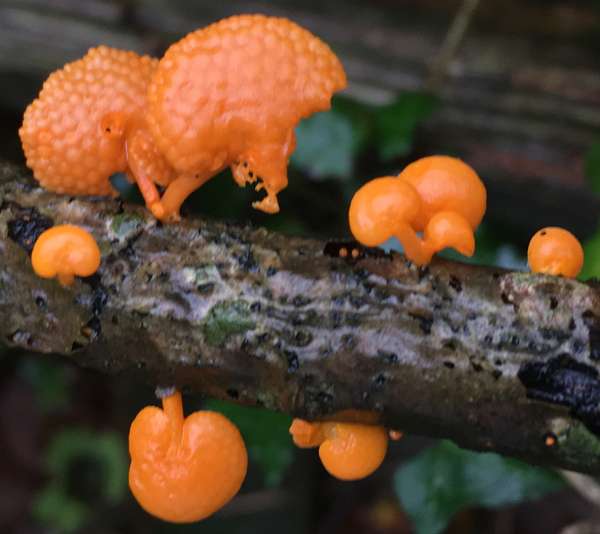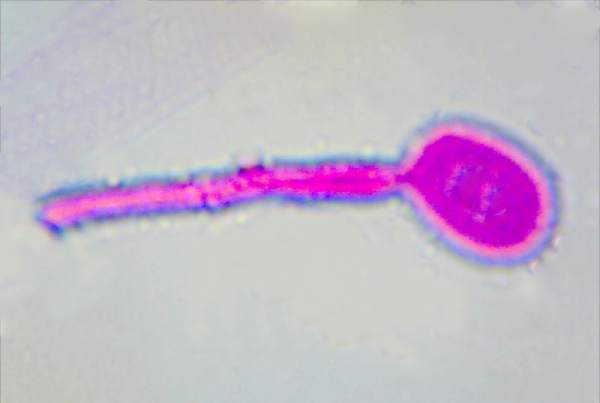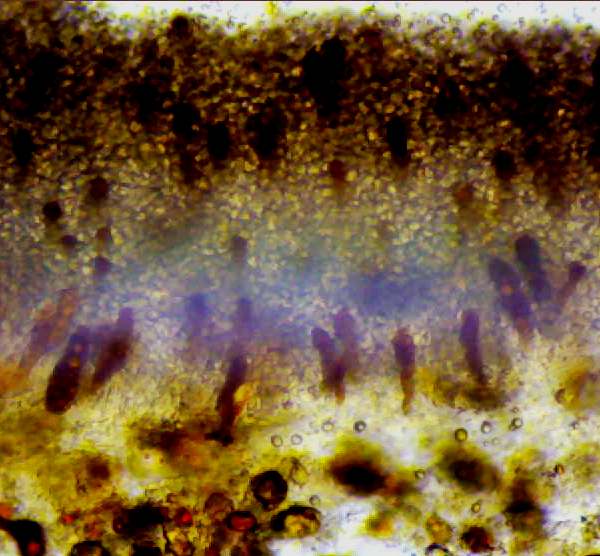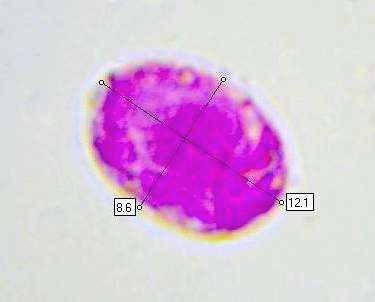Favolaschia claudopus Q.Y. Zhang & Y.C. Dai - Orange Porecap
Phylum: Basidiomycota - Class: Agaricomycetes - Order: Agaricales - Family: Mycenaceae
Distribution - Taxonomic History - Etymology - Identification - Culinary Notes - Reference Sources
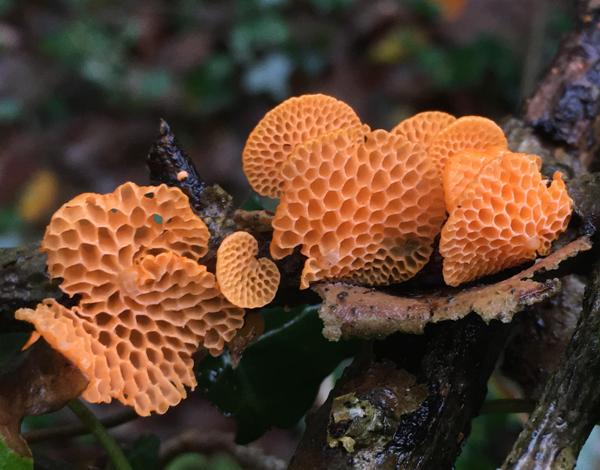
Look out for these rare poroid mushrooms in damp deciduous broadleaf or mixed woodlands, where they grow most often on fallen twigs and branches.
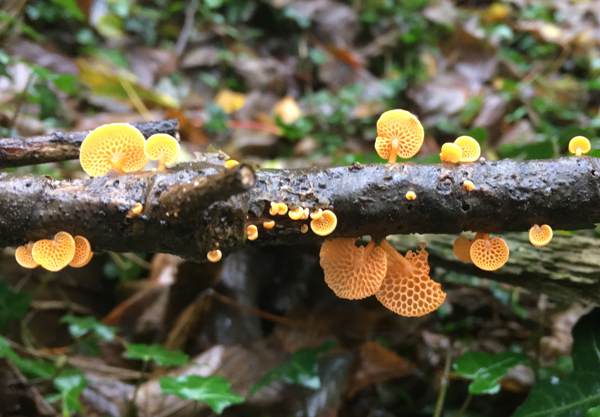
Most members of the family Mycenaceae species have dull caps, central stems and pale gills, but these bright orange relatives of the bonnet mushrooms have large pores and excentric and often almost lateral stems, giving them the appearance of miniature ping-pong bats.
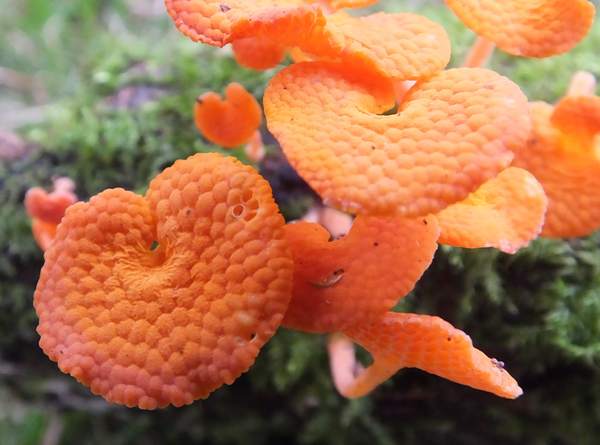
We fount the specimens pictured above and immediately below in damp, shady woodland beside a small stream in Buckland Monachorum, near Yelverton, Devon, in the last week of September 2022.
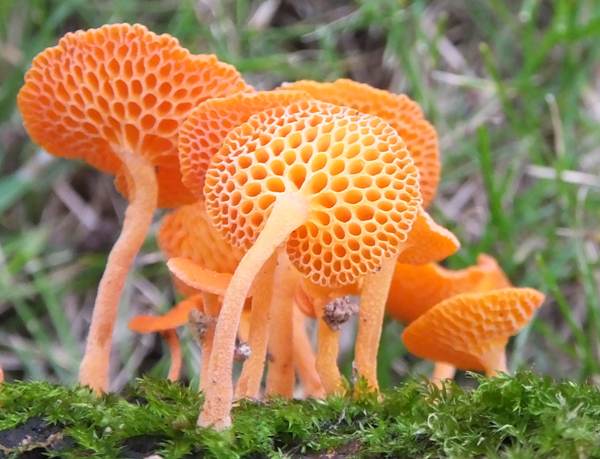
Distribution
In Britain the Orange Porecap is a recent introduction (or maybe the appearance of this sub-tropical species is the result of global warming); it is currently recorded from Devon and Cornwall. This striking pored member of the family Mycenaceae originated in Madagascar, from where it spread - presumably when timber was being shipped - to Australia and New Zealand. Over the past couple of decades the Orange Porecap has been spreading across Europe, and its range now includes parts of Italy, Spainlittle bonnet mushroom occurs throughout mainland Europe and many other parts of the world including North America.
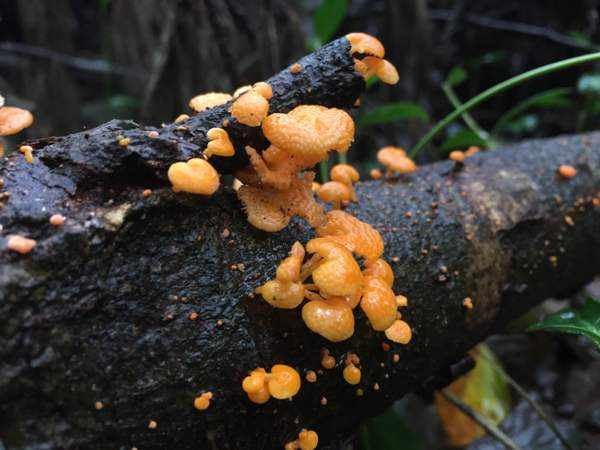
Taxonomic history
French mycologist Roger Heim (1900 - 1979), who recorded this little wood-rotting fungus as early as 1945, described this mushroom in1966, giving it the scientific name Favolaschia claudopus. (Heim worked for some time in Mexico with the ethnomycologist Robert Gordon Wasson, studying, inter alia, hallucinogenic mushrooms in the genera Psilocybe and Stropharia.) These intriguing little fungi were generally known by that name until 2021, when genetic sequencing by Q.Y. Zhang & Y.C. Dai showed Favolaschia calopus to be a complex of six distinct species. The specimens found in south-west England have been shown to be Favolaschia claudopus.
The other species extracted from the Favolaschia calopus complex are F. minutissima, F. brevibasidiata, F. calocera, F. longistipitata and F. brevistipitata.
Etymology
The genus name Favolaschia comes from the Latin favus, meaning a honeycomb - a reference to the large honeycomb-like pores on the fertile surface - and to the fact that this group of fungi was originally included in the now obsolete genus Laschia, named in honour of the german botanist Wilhelm Gottfried Lasch (1787-1863).
Calo- as a prefix means beautiful, while the extension -cera comes from ancient Greek and means 'like wax', so that the specific epithet calocera translates to 'beautiful and waxy'; however, the newly-created specific epithet claudopus is less obvious. From Latin we get claudo- meaning a key, bar or bolt, while -pus refers to the foot or stem of the mushroom. Take from that what you will, but it doesn't suggest an awful lot to me. Any ideas welcomed...
Identification guide
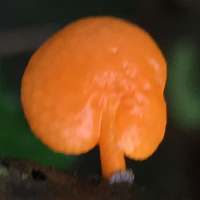 |
Cap0.5 to 2cm across; broadly convex, infertile surface (left) smooth when young then developing undulations in a pattern corresponding to the pores on the fertile surface; lobed either side of the lateral stem to for a kidney shape; bright orange when fres, turning brownish orange when dry.
|
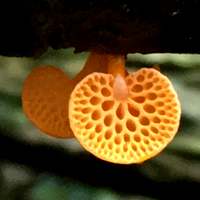 |
Pores0.3 to 2.5mm across, larger ellipsoidal pores nearest to the stem and smaller more angular pores near the cap margin; bright orange. |
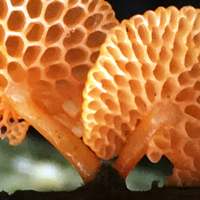 |
Stem0.8 to 2.5mm diameter, 1.5 to 15mm long; cylindrical or tapering slightly towards apex; orange, smooth; no stem ring. |
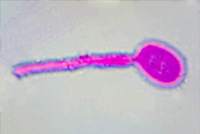 |
CheilocystidiaCystidia on the pore edges are acanthocysts (cystidia covered in tiny rod-like projecting diverticulae); 8.5-14 x 35-52µm, mostly cylindrical to subclavate, apex rounded.
|
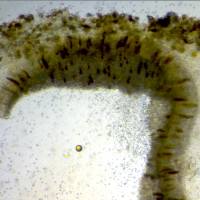 |
Pleurocystidia and pileocystidiaCystidia on the tube walls and in the pileipellis are mainly cylindrical or narrowly clavate gloeocysts (filled with oily/granular dark-coloured material); 8.5-12.5µm diameter and typically 30µm long..
|
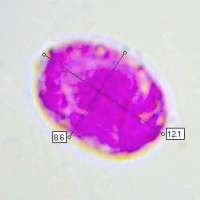 |
SporesOvoid or ellipsoidal, smooth, 9-12.5 x 6.5-8.5µm; hyaline; weakly amyloid. (Basidia mostly two-spored.)
Spore printWhite. |
Odour/taste |
Not distinctive. |
Habitat & Ecological role |
Saprophytic, gregarious on rotten wood such as Elder Sambucus nigra, Sycamore Acer pseudoplatanus, and Beech Fagus sylvatica. This is a mushroom of damp, shady woodlands or thickets. |
Season |
July to November in Britain and Ireland. |
Similar species |
Orange Porecap is very distinctive and unlikely to be confused with any other species in Britain; however, it's worth noting that elsewhere in the world there are more than 50 other Favolaschia species. |
Culinary notes
These little fungi are of no culinary interest. It is unclear whether they are toxic or not.
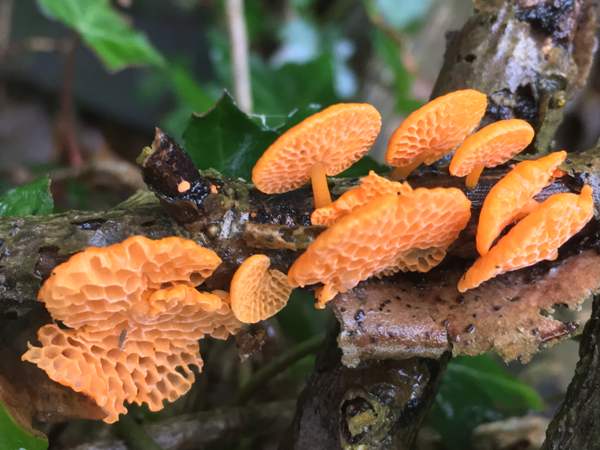
Reference Sources
Favolaschia claudopus Q.Y. Zhang & Y.C. Dai, Forests 12(10, no. 1397): 9 (2021)
Invasion of the Orange Ping-Pong Bats: the rapidly changing distribution of Favolaschia calocybe; A. Martyn Ainsworth, David Farley, Paul Gainey, Pauline Penna & Laura M. Suz; Field Mycology Volume 16 (4) Oct. 2015, British Mycological Society.
The basidiomycete genus Favolaschia in New Zealand; P.R. Johnston , S.R. Whitton , P.K. Buchanan , D. Park , S.R. Pennycook , J. E. Johnson & J. M. Moncalvo; New Zealand Journal of Botany, 2006, Vol. 44: 65-87
Dictionary of the Fungi; Paul M. Kirk, Paul F. Cannon, David W. Minter and J. A. Stalpers; CABI, 2008
Taxonomic history and synonym information on these pages is drawn from many sources but in particular from the British Mycological Society's GB Checklist of Fungi.
Acknowledgements
This page includes pictures kindly contributed by Simon Harding.
Fascinated by Fungi. Back by popular demand, Pat O'Reilly's best-selling 450-page hardback book is available now. The latest second edition was republished with a sparkling new cover design in September 2022 by Coch-y-Bonddu Books. Full details and copies are available from the publisher's online bookshop...

